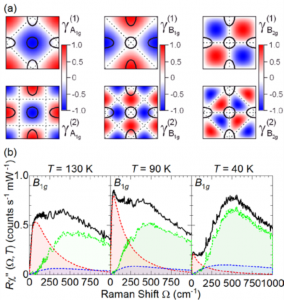OVERVIEW

(a) Symmetry properties and momentum dependencies of the Raman vertices. Shown are the first and second order vertices for polarization orientations transforming as A1g, B1g and B2g symmetries of the D4h space group. The solid lines represent an idealized two-band Fermi surface of FeBSCs in the 1 Fe unit cell. (b) Phenomenological decomposition of the FeSe B1g Raman data at three characteristic temperatures. Adapted from [5, 6].
Discovery of superconductivity in the Fe-based materials (FeBSCs) in 2008 brought new excitement in the field of high-Tc superconductors [1]. It gave us new clues in the decades-long struggle for deciphering the mystery behind the high-Tc superconductors. Although much has been learned since, some of the key questions regarding the complex interplay between lattice, magnetism and superconductivity, are still controversial. While posing the challenge, close proximity of the phases in FeBCS can be facilitated through tuning of their properties by applying strain as an additional control parameter [2,3]. Access to the various degrees of freedom can provide the valuable data needed, not only for pinpointing the generic properties and, possibly, understanding of the FeBSCs, but also for material/device engineering.
Inelastic scattering of visible light (Raman effect) has the capability to simultaneously probe lattice, charge and spin excitations as well as their mutual interactions and is well established as an indispensable tool for research into high-Tc superconductors [4]. The respective symmetry selection rules allow one to pin down the type of excitation and to get k-resolved information about the electrons [see Fig. (a)]. Through the linear combinations of spectra, measured for different polarization configurations, pure symmetry spectra are calculated [see Fig. (b)]. By varying parameters such as temperature and strain, valuable data incisive for understanding of these (multi-band) systems can be obtained.
While being the member of the FeBSC family with the simplest crystallographic structure, FeSe represents a fascinating example of the interplay between the phases. The superconducting transition temperature ranges from 8.9 K in the bulk to almost 100 K for a monolayer on SrTiO3. This huge increase in Tc was traced back to the combination of different pairing mechanisms.
In the pure B1g symmetry of FeSe single crystals Raman spectra [5, 7-10], aside from the response from particle-hole excitations, a strong contribution at energies of order kBT is observed with spectral weight peaking at the nematic phase transition [see Fig. (b)]. Currently, it is not settled whether the fluctuations observed by light scattering are related to spin or charge. Another controversy is about possible two-magnon excitations at about 500 cm-1. Whilst this response can also originate from charge excitations, as in most of the Fe-based compounds, theory and experiment suggest that the observed high-energy excitations can be traced back to localized spins in a nearly frustrated system. If these controversies could be settled, the driving force behind the phase transitions in iron-chalcogenides would be identified.
[1] G. R. Stewart, Superconductivity in iron compounds, Rev. Mod. Phys. 83, 1589 (2011).
[2] T. Kissikov et al., Uniaxial strain control of spin-polarization in multicomponent nematic order of BaFe2As2, Nat. Commun., 9,1058 (2018).
[3] C. M. Yim et al., Discovery of a strain-stabilised smectic electronic order in LiFeAs, Nat. Commun, 9, 2602 (2018).
[4] T. P. Devereaux and R. Hackl, Inelastic light scattering from correlated electrons, Rev. Mod. Phys. 79, 175 (2006)
[5] A. Baum at al., Frustrated spin order and stripe fluctuations in FeSe, Commun. Phys. 2, 14 (2019).
[6] N. Lazarevic and R. Hackl, Fluctuations and pairing in Fe-based superconductors: light scattering experiments, Phys.: Condens. Matter 32, 413001 (2020)
[7] P. Massat et al. , Charge-induced nematicity in FeSe PNAS, 113 (33) 9177-9181, (2016)
[8] V. Gnezdilov et al., Interplay between lattice and spin states degree of freedom in the FeSe superconductor: Dynamic spin state instabilities, Phys. Rev. B 87, 144508, (2013)
[9] W.-L. Zhang et al., Stripe quadrupole order in the nematic phase of FeSe1−x Sx arXiv:1710.09892, (2018)
[10] P. Massat et al. Collapse of Critical Nematic Fluctuations in FeSe under Pressure, Phys. Rev. Lett. 121, 077001 (2018)
